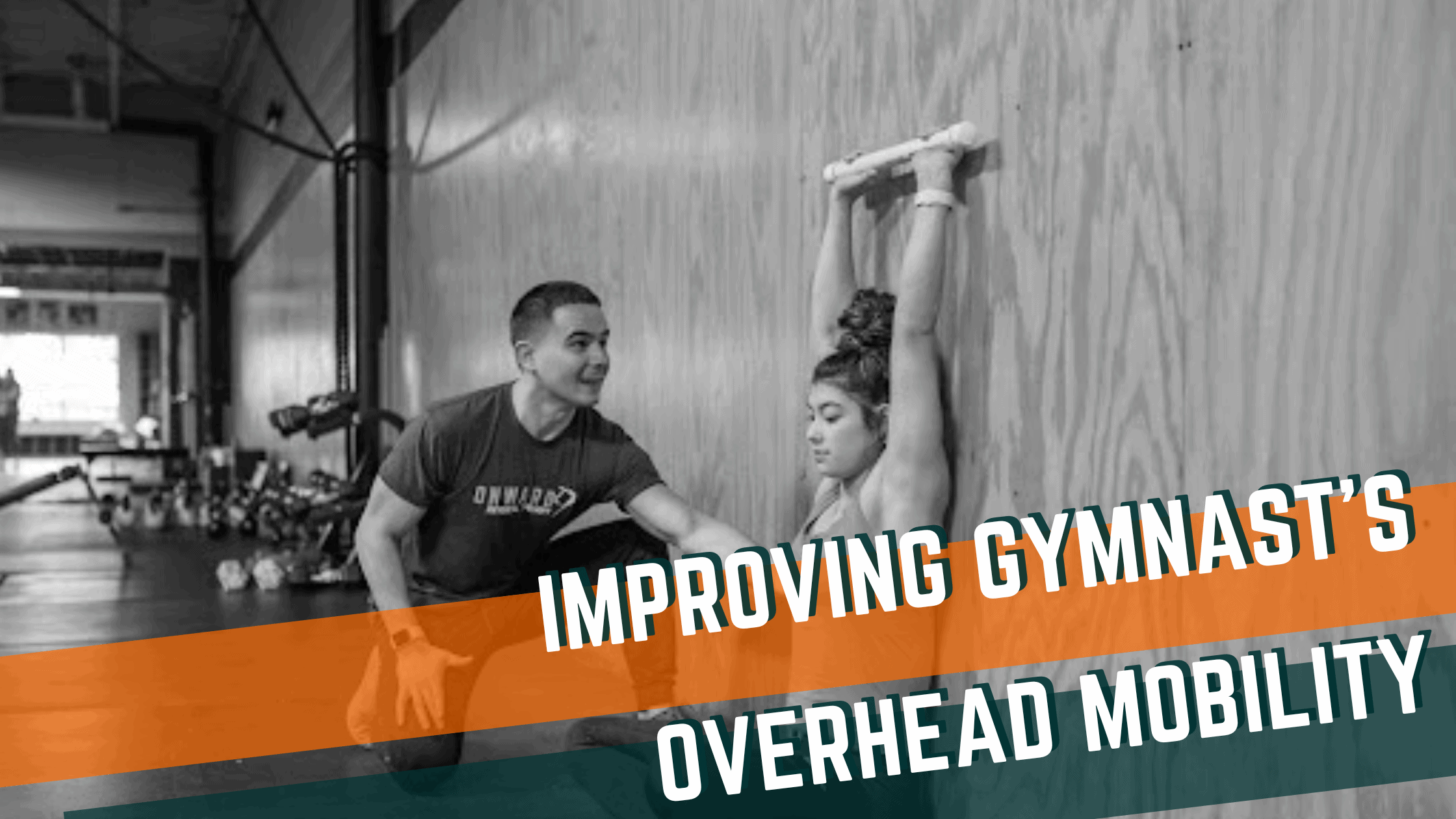
For a gymnast to have proper technique in commonly performed skills using a handstand position or going through a handspring motion; full shoulder mobility is required. A gymnast not only needs to be able full flexibility of the shoulders overhead, but they must be able to show full strength and control in that position. This allows for optimal technique and force development with skill progression.
At Onward Physical Therapy we commonly see gymnasts who have very mobile joints, but the musculature around the shoulder joint are very tight due to the overuse in the muscles over years of training in specific ways. We also see gymnasts who are actually mobile enough, but the muscles in the back of the shoulder are not strong enough to hold the position through the high forces that gymnastics places on the upper body when upside down.
Improving Gymnast Mobility with Simple Exercises
The exercise series listed below is a great starting point for most gymnasts we work with to properly stretch the tight muscles limiting overhead while strengthening the muscles needed to control the range. Give the exercise series a try to improve your gymnasts overhead mobility.
Lat Foam Rolling
View Video: https://www.youtube.com/shorts/WsO0LWNrAJY
Foam rolling the muscles (Latissimus dorsi and teres major) along the side/back of the shoulder for 1 minute is a great way to relax the muscles that limit overhead motion to allow for more benefit with the stretches to follow.
Gymnastics Lat Stretch
View Video: https://www.youtube.com/shorts/l0m7HUk1F2U
Properly stretching the same muscle group is very important for a gymnast as this muscle group is not commonly targeted with traditional gymnastics stretching. To properly target the lat muscles a gymnast must keep a hollow position as any arching will shorten the muscle and not allow the stretch to be felt in the proper area.
Hold this stretch for 1 minute per side feeling the stretch in the under arm and side of the back (NOT the top of the shoulder joint)
Eccentric Lat Stretch
View Video: https://www.youtube.com/shorts/WXJ1TUibZPo
Following up foam rolling and static stretching with eccentric stretching is a great way to further lengthen the muscle but also engage strength and control. For a gymnast to target the right muscles we need to keep our hips tucked and rib caged hollow throughout the whole motion. Try 10 reps with a 3 second lower down and a 2 second hold at the end.
Tucked Overhead Press
View Video: https://www.youtube.com/shorts/4vDXtmC-qo4
Once a gymnast has opened up their flexibility overhead we will want to reinforce the changes with strengthening the opposite muscles in the proper overhead position. Sitting in a tucked position will be a great way to limit compensation during a dumbbell overhead press. Using a moderate dumbbell where a gymnast can do around 15 reps is a great place to start with a focus on covering the ears overhead without leaning back out of the tucked position at the top.
Tucked Handstand Shrugs
View Video: https://www.youtube.com/shorts/h8Cf59uGTLM
Getting upside down and developing strength in the handstand position must be included to match the needs of gymnastics skills. Tucking the hips and low back while facing the wall is another great way to not allow a gymnast to compensate into the wrong position. Once the arms are as close to the wall as possible perform 15 slow shrugs forcing a strong and tall position to build strength in the shoulders while upside down.
In Conclusion…
Targeting the proper muscle groups with stretching and strengthening gives gymnasts fast, effective, and long lasting results in their overhead mobility. A gymnast will immediately see improved handstand positions needed on all events and the ability to fully open their shoulders in their handspring skills. Adding in strength exercises will also allow for a really strong blocking position to maximize height off the vault and reduce the arms buckling on impact.
Having full shoulder mobility is also crucial in decreasing stress on the lower back, wrists, and elbows while performing these handstands and handspring based skills. Any limitations in the shoulders require more force on other areas of the body to make up for the lack of motion at the shoulder. Overtime as this happens we commonly see overuse injuries related to tight shoulders.
Does your gymnast have limited overhead mobility affecting their performance? Chronic overuse injuries which never seem to fully go away? Try these exercises first, but for a more specific plan we are here to help!
At Onward Physical Therapy, we specialize in gymnastics physical therapy. If you would like to know more about how we can help your gymnasts’ pain while maximizing their performance in the gym, schedule a free phone consultation today!
Recent Articles
Why Early Intervention Physical Therapy Accelerates Your Recovery

What to Expect at Your First Physical Therapy Session?

How to Choose a Physical Therapist

The Top 5 Misconceptions About Physical Therapy

The Complete Guide to Physical Therapy

